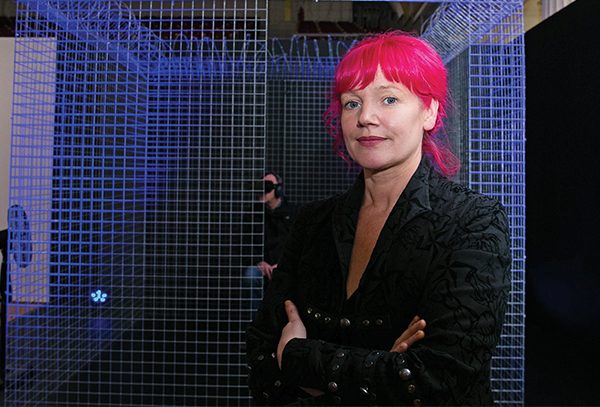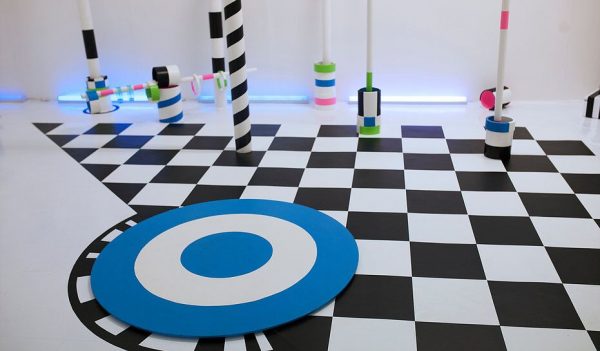
Pictured above: Elaine Hoey was awarded the €10,000 RDS Taylor Art Award for her creation ‘The Weight of Water’.
The inaugural RDS Visual Art Awards Exhibition, showcasing the work of some of the best and most exciting artists coming out of Ireland’s art colleges this year, was launched in the RDS Concert Hall on October 25th.
Exhibiting artists were in with a chance to win a share of the €20,000 prize fund, including the RDS Taylor Art Award (€10,000), the R.C. Lewis-Crosby Award, and the RDS Monster Truck Studio Award.
The award winners were announced at the launch.

The artworks included in this year’s exhibition touched on a range of themes, including capitalism, war, time and space, contemporary image making, the relationship between costume and identity, grief, trauma, the dangers of credulity, the built environment, presence, absence and things that are not of this world. The show itself was a good reflection of things that are of this world and of this time.
Elaine Hoey won the prestigious RDS Taylor Art Award for her high-tech artwork: The Weight of Water.
She used Virtual Reality (VR) technology fused with gaming technology to create the work, which explores the reality of crisis migration.
To experience The Weight of Water each individual viewer, although ‘participant’ would be a more appropriate word, is required to wear a virtual reality headpiece and headphones. Total immersion is the goal of VR technology – to create what appears to be a life-size, 3D virtual environment.
In this case, as soon as the viewer dons the headset they find that they are seated in a boat at sea. It feels real. The boat is cast in shadows, enveloped by the swirling dark waters of the night tide. Through the darkness searchlights from a larger boat, anchored in the distance, highlight the white tips of breaking waves and the faces of their fellow travellers. Overhead, a full size helicopter hovers, watching silently. The only sound is the swish of waves breaking gently against the sides of the boat.
As the viewer adjusts to this virtual world they discover that they are not in the company of ordinary travellers, off to explore the world, but share the boat with a group of refugees, displaced by war. They are seated close up, in front and behind, shoulder to shoulder, so close that you could reach out and touch those seated nearby.
Some huddle close in family groups with accompanying children while others are alone. They have no luggage. They do not speak but sit quietly, barely moving. Having escaped the immediate danger of conflict, they now risk all for an uncertain future. Occasionally, one of them catches your eye, exchanges a glance, before resuming their watch. They gaze impassively towards their destination, into the darkness, into the future, not knowing what lies ahead.
But the viewer knows what lies ahead, and this is the point. Seated amongst them, the viewer is fully aware that their ordeal is far from over. They may have escaped bombs and bullets and unspeakable acts of brutality but they are facing new dangers if they reach what they hope will be a place of safety.
They don’t know that the native populations of the countries they are going to have been primed by a largely unsympathetic media to view them as “other”; a threat to the natural order. Instead of being greeted with humanity and empathy, most will face hostility, suspicion, indifference, rejection, poverty, alienation and exploitation.
The Weight of Water provokes an emotional response in the viewer. It takes seven and a half minutes to view but lingers in the mind long after the viewing experience is over.
Hoey told NewsFour: “I noticed how I was responding to the images of migrants coming across on TV.
How detached I felt at times and how public opinion was fluctuating from sympathy to indifference, and then immediately after a news report there would be an ad for Dove or something. After a time it [the refugees’ predicament] was not seen as a humanitarian crisis but as a threat. I got quite upset about that.”
Hoey feels honoured to have been chosen to receive this year’s RDS Taylor Art Award, which has been won in the past by some of Ireland’s greatest artists including Walter Osborne, William Orpen, Melanie le Brocquy, Dorothy Cross and James Hanley. She plans to invest the €10,000 prize money in equipment, explaining: “My medium is technology, which is expensive. At the moment I can’t work when I’m exhibiting because I need the equipment both to show and to create my work. I want to get working again.” For her, the real joy of the award was the experience of being part of the show, which was “wonderfully curated by Alice Maher.” She said, “knowing that such eminent artists and people from the art world are looking at my work is a thrilling experience.”
By Jennifer Reddin



